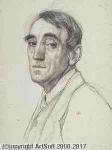Theo Van Rysselberghe
Theo Van Rysselberghe
Style: Pointillism; Post Impressionism; Post-Impressionism; Abstract Expressionism;
Place: Ghent
Born: 1862
Death: 1926
Biography:
Early Life and Training
Theo Van Rysselberghe, a prominent figure in the European art scene at the turn of the century, was born on November 23, 1862, in Ghent, Belgium, to a French-speaking bourgeois family. He began his artistic journey under the tutelage of Theo Canneel at the Academy of Ghent and later studied at the Académie Royale des Beaux-Arts in Brussels from 1879.
Artistic Evolution and Influences
Van Rysselberghe's early work, such as Self-Portrait with Pipe (1880), was characterized by somber colors, reflecting the Belgian realistic tradition of that time. However, his Child in an open spot of the forest (1880) marked a departure from this style and an early step towards impressionism. His subsequent travels to Morocco (1882-1888) significantly influenced his work, as seen in Arabian street cobbler (1882), Arabian boy (1882), and Resting guard (1883).
Founding of Les XX and Notable Works
As a co-founder of the Belgian artistic circle Les XX on October 28, 1883, Van Rysselberghe played a pivotal role in the European art scene. His Arabian phantasia (1884), a large, exotic painting, is his best-known work from this period, showcasing his obsession with light.
Legacy and Museum Collections
Van Rysselberghe's legacy can be seen in various museum collections, including the Museum voor Schone Kunsten (Ghent, Belgium), which houses several of his works, such as A Reading and Self Portrait with Pipe [sketch]. His influence on the development of neo-impressionism in Europe is undeniable.
- Museum Collections:
- Musee du Luxembourg (France) - featuring Pointe-Saint-Pierre, Saint-Tropez
- Theo Van Rysselberghe's Collection on Wikioo.org
Conclusion
Theo Van Rysselberghe, a Belgian neo-impressionist painter, left an indelible mark on the European art scene. His artistic evolution, influenced by his travels and interactions with other artists, resulted in a unique style that continues to captivate audiences. Explore more of his works and legacy on Wikioo.org.
Wikipedia link: Click Here














